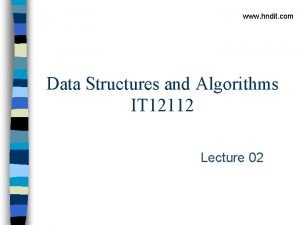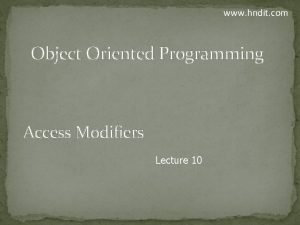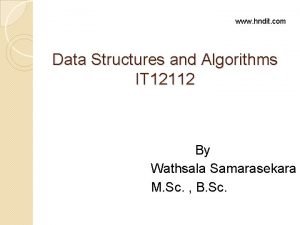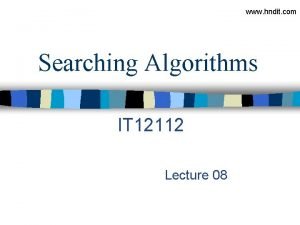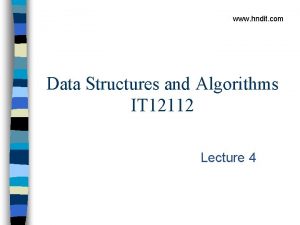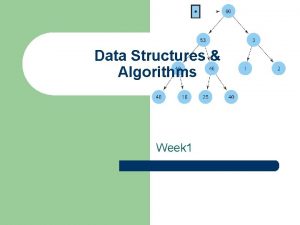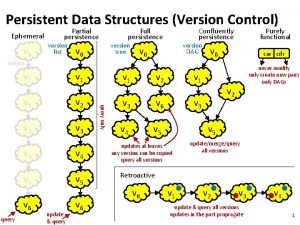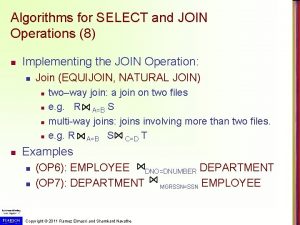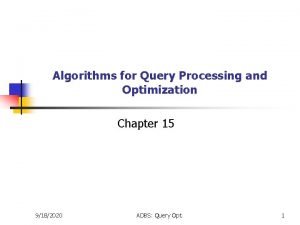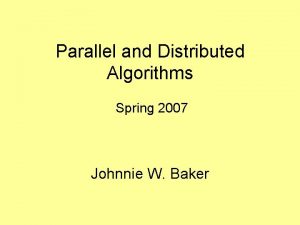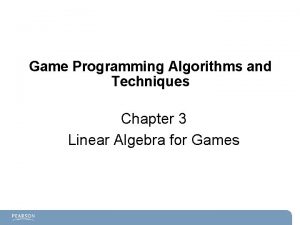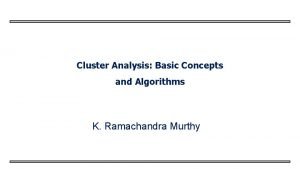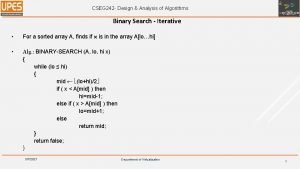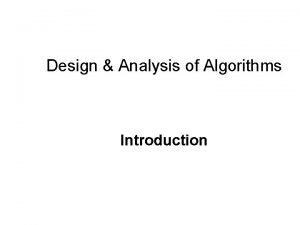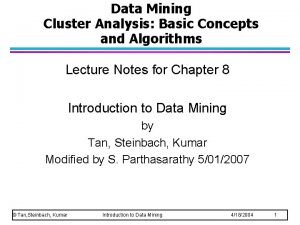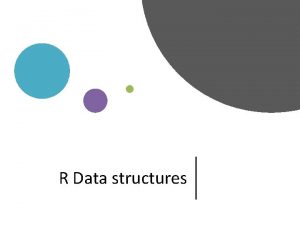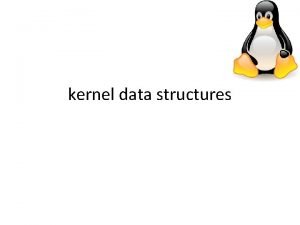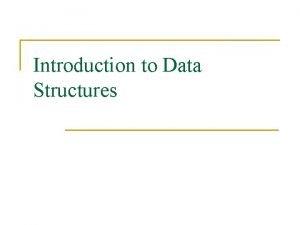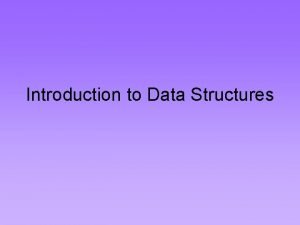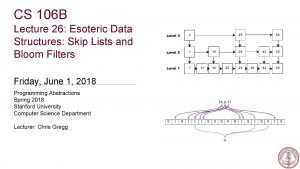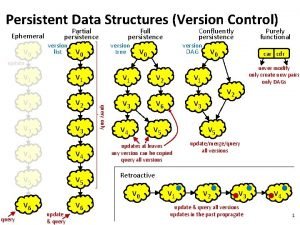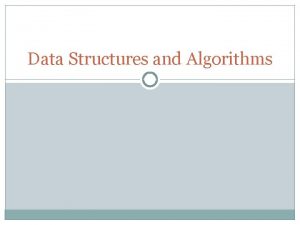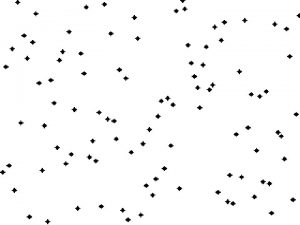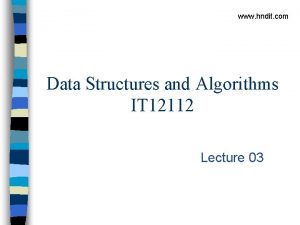www hndit com Data Structures and Algorithms IT









































































- Slides: 73

www. hndit. com Data Structures and Algorithms IT 12112 Lecture 4

Linked List www. hndit. com n To overcome the disadvantage of fixed size arrays, linked list were introduced. n A linked list consists of nodes of data which are connected with each other. Every node consist of two parts data and the link to other nodes. n The nodes are created dynamically.

Linked List www. hndit. com The Linked List is a more complex data structure than the stack and queue. A Linked List consists of two parts, one the DATA half and the POINTER half. The Data half contains the data that we want to store while the pointer half contains a pointer that points to the next linked list data structure. This way we have a dynamic data structure as we can add as much data as we want within memory restrictions. And yes, pointers play a major role in Data structures. . . No Pointers, No Data Structures. . . So Knowledge of Pointers is a basic must before continuing.

Linked Lists n www. hndit. com Flexible space use – Dynamically allocate space for each element as needed – Include a pointer to the next item çLinked list – Each node of the list contains • the data item (an object pointer in our ADT) • a pointer to the next node Data Next object

Linked Lists n www. hndit. com Collection structure has a pointer to the list head – Initially NULL Collection Head

Linked Lists www. hndit. com Collection structure has a pointer to the list head – Initially NULL n Add first item – Allocate space for node – Set its data pointer to object – Set Next to NULL – Set Head to point to new node n Collection Head node Data Next object

Linked Lists n www. hndit. com Add second item – – Allocate space for node Set its data pointer to object Set Next to current Head Set Head to point to new node Collection Head node Data Next object 2 Data Next object

The composition of a Linkedwww. hndit. com List n A linked list is called "linked" because each node in the series has a pointer that points to the next node in the list. 8

Declarations n www. hndit. com First you must declare a data structure that will be used for the nodes. For example, the following struct could be used to create a list where each node holds a float: struct List. Node { float value; struct List. Node *next; }; 9

Declarations www. hndit. com n The next step is to declare a pointer to serve as the list head, as shown below. List. Node *head; • Once you have declared a node data structure and have created a NULL head pointer, you have an empty linked list. • The next step is to implement operations with the list. 10

www. hndit. com Linked List Operations n We will use the following class declaration (on the next slide), which is stored in Float. List. h. 11

class Float. List www. hndit. com { private: // Declare a structure for the list struct List. Node { float value; struct List. Node *next; }; List. Node *head; // List head pointer public: Float. List(void) // Constructor { head = NULL; } ~Float. List(void); // Destructor void append. Node(float); void insert. Node(float); void delete. Node(float); void display. List(void); }; 12

Appending a Node to thewww. hndit. com List To append a node to a linked list means to add the node to the end of the list. n The pseudocode is shown below. The C++ code follows. n Create a new node. Store data in the new node. If there are no nodes in the list Make the new node the first node. Else Traverse the List to Find the last node. Add the new node to the end of the list. End If. 13

void Float. List: : append. Node(float num) www. hndit. com { List. Node *new. Node, *node. Ptr; // Allocate a new node & store num new. Node = new List. Node; new. Node->value = num; new. Node->next = NULL; // If there are no nodes in the list // make new. Node the first node if (!head) head = new. Node; else // Otherwise, insert new. Node at end { // Initialize node. Ptr to head of list node. Ptr = head; // Find the last node in the list while (node. Ptr->next!=NULL) node. Ptr = node. Ptr->next; // Insert new. Node as the last node. Ptr->next = new. Node; } } 14

Implementation www. hndit. com // This program demonstrates a simple append // operation on a linked list. #include <iostream. h> #include "Float. List. h” void main(void) { Float. List; list. append. Node(2. 5); list. append. Node(7. 9); list. append. Node(12. 6); } (This program displays no output. ) 15

www. hndit. com Stepping Through the Program n The head pointer is declared as a global variable. head is automatically initialized to 0 (NULL), which indicates that the list is empty. n The first call to append. Node passes 2. 5 as the argument. In the following statements, a new node is allocated in memory, 2. 5 is copied into its value member, and NULL is assigned to the node's next pointer. 16

www. hndit. com new. Node = new List. Node; new. Node->value = num; new. Node->next = NULL; 17

www. hndit. com The next statement to execute is the following if statement. if (!head) head = new. Node; There are no more statements to execute, so contro returns to function main. 18

www. hndit. com In the second call to append. Node, 7. 9 is passed as the argument. Once again, the first three statements in the function create a new node, store the argument in the node's value member, and assign its next pointer to NULL. 19

Since head no longer points to NULL, the else part of the if statement www. hndit. com executes: else { // Otherwise, insert new. Node at end // Initialize node. Ptr to head of list node. Ptr = head; // Find the last node in the list while (node. Ptr->next) node. Ptr = node. Ptr->next; // Insert new. Node as the last node. Ptr->next = new. Node; } 20

www. hndit. com node. Ptr is already at the end of the list, so the while loop immediately terminates. The last statement, node. Ptr->next = new. Node; causes node. Ptr->next to point to the new node. This inserts new. Node at the end of the list. 21

www. hndit. com The third time append. Node is called, 12. 6 is passed as the argument. Once again, the first three statements create a node with the argument stored in the value member. 22

www. hndit. com next, the else part of the if statement executes. As before, node. Ptr is made to point to the same node as head. 23

Since node. Ptr->next is not NULL, the while loop will execute. After its first iteration, node. Ptr will point to the second node in the list. 24

www. hndit. com The while loop's conditional test will fail after the first iteration because node. Ptr->next now points to NULL. The last statement, node. Ptr->next = new. Node; causes node. Ptr->next to point to the new node. This inserts new. Node at the end of the list The figure above depicts the final state of the linked list. 25

Traversing the List n www. hndit. com The display. List member function traverses the list, displaying the value member of each node. The following pseudocode represents the algorithm. The C++ code for the member function follows on the next slide. Assign List head to node pointer. While node pointer is not NULL Display the value member of the node pointed to by node pointer. Assign node pointer to its own next member. End While. 26

www. hndit. com void Float. List: : display. List(void) { List. Node *node. Ptr; node. Ptr = head; while (node. Ptr) { cout << node. Ptr->value << endl; node. Ptr = node. Ptr->next; } } 27

Implementation www. hndit. com // This program calls the display. List member function. // The funcion traverses the linked list displaying // the value stored in each node. #include <iostream. h> #include "Float. List. h" void main(void) { Float. List; list. append. Node(2. 5); list. append. Node(7. 9); list. append. Node(12. 6); list. display. List(); } 28

www. hndit. com Output 2. 5 7. 9 12. 6 29

www. hndit. com Inserting a Node n Using the list. Node structure again, the pseudocode on the next slide shows an algorithm for finding a new node’s proper position in the list and inserting there. n The algorithm assumes the nodes in the list are already in order. 30

www. hndit. com Create a new node. Store data in the new node. If there are no nodes in the list Make the new node the first node. Else Find the first node whose value is greater than or equal the new value, or the end of the list (whichever is first). Insert the new node before the found node, at the end of the list if no node was found. End If. 31

The code for the traversal algorithm is shown below. (As before, num www. hndit. com holds the value being inserted into the list. ) // Initialize node. Ptr to head of list node. Ptr = head; // Skip all nodes whose value member is less // than num. while (node. Ptr != NULL && node. Ptr->value < num) { previous. Node = node. Ptr; node. Ptr = node. Ptr->next; } The entire insert. Node function begins on the next slide. 32

void Float. List: : insert. Node(float num) { List. Node *new. Node, *node. Ptr, *previous. Node; // Allocate a new node & store Num new. Node = new List. Node; new. Node->value = num; www. hndit. com // If there are no nodes in the list // make new. Node the first node if (!head) { head = new. Node; new. Node->next = NULL; } else // Otherwise, insert new. Node. { // Initialize node. Ptr to head of list node. Ptr = head; // Skip all nodes whose value member is less // than num. while (node. Ptr != NULL && node. Ptr->value < num) { previous. Node = node. Ptr; node. Ptr = node. Ptr->next; } Continued on next slide… 33

Continued from previous slide. www. hndit. com // If the new node is to be the 1 st in the list, // insert it before all other nodes. if (previous. Node == NULL) { head = new. Node; new. Node-> = node. Ptr; } else { previous. Node->next = new. Node; new. Node->next = node. Ptr; } } } 34

Implementation www. hndit. com // This program calls the display. List member function. // The function traverses the linked list displaying // the value stored in each node. #include <iostream. h> #include "Float. List. h” void main(void) { Float. List list; // Build the list. append. Node(2. 5); list. append. Node(7. 9); list. append. Node(12. 6); // Insert a node in the middle // of the list. insert. Node(10. 5); // Dispay the list. display. List(); 35 }

www. hndit. com Output 2. 5 7. 9 10. 5 12. 6 36

In insert. Node, a new node is created and the function argument is copied to its value member. Since the list already has nodes stored in it, the else part of the if statement will execute. It begins by assigning node. Ptr to head. 37

www. hndit. com Since node. Ptr is not NULL and node. Ptr->value is less than num, the while loop will iterate. During the iteration, previous. Node will be made to point to the node that node. Ptr is pointing to. node. Ptr will then be advanced to point to the next node. 38

Once again, the loop performs its test. Since node. Ptr is not NULL and node. Ptr->value is less than num, the loop will iterate a second time. During the second iteration, both previous. Node and node. Ptr are advanced by one node in the list. 39

www. hndit. com This time, the loop's test will fail because node. Ptr is not less than num. The statements after the loop will execute, which cause previous. Node->next to point to new. Node, and new. Node->next to point to node. Ptr. If you follow the links, from the head pointer to the NULL, you will see that the nodes are stored in the order of their value members. 40

Deleting a Node www. hndit. com n Deleting a node from a linked list requires two steps: – Remove the node from the list without breaking the links created by the next pointers – Deleting the node from memory n The delete. Node function begins on the next slide. 41

void Float. List: : delete. Node(float num) www. hndit. com { List. Node *node. Ptr, *previous. Node; // If the list is empty, do nothing. if (!head) return; // Determine if the first node is the one. if (head->value == num) { node. Ptr = head->next; delete head; head = node. Ptr; } Continued on next slide… 42

Continued from previous slide. www. hndit. com else { // Initialize node. Ptr to head of list node. Ptr = head; // Skip all nodes whose value member is // not equal to num. while (node. Ptr != NULL && node. Ptr->value != num) { previous. Node = node. Ptr; node. Ptr = node. Ptr->next; } // Link the previous node to the node after // node. Ptr, then delete node. Ptr. previous. Node->next = node. Ptr->next; delete node. Ptr; } 43

Implementation www. hndit. com // This program demonstrates the delete. Node member function #include <iostream. h> #include "Float. List. h“ void main(void) { Float. List list; // Build the list. append. Node(2. 5); list. append. Node(7. 9); list. append. Node(12. 6); cout << "Here are the initial values: n"; list. display. List(); cout << endl; cout << "Now deleting the node in the middle. n"; cout << "Here are the nodes left. n"; list. delete. Node(7. 9); list. display. List(); 44 cout << endl; Continued on next slide…

Continued from previous slide. www. hndit. com cout << "Now deleting the last node. n"; cout << "Here are the nodes left. n"; list. delete. Node(12. 6); list. display. List(); cout << endl; cout << "Now deleting the only remaining node. n"; cout << "Here are the nodes left. n"; list. delete. Node(2. 5); list. display. List(); } 45

Output www. hndit. com Here are the initial values: 2. 5 7. 9 12. 6 Now deleting the node in the middle. Here are the nodes left. 2. 5 12. 6 Now deleting the last node. Here are the nodes left. 2. 5 Now deleting the only remaining node. Here are the nodes left. 46

Look at the else part of the second if statement. This is where the www. hndit. com function will perform its action since the list is not empty, and the first node does not contain the value 7. 9. Just like insert. Node, this function uses node. Ptr and previous. Node to traverse the list. The while loop terminates when the value 7. 9 is located. At this point, the list and the other pointers will be in the state depicted in the figure below. 47

next, the following statement executes. www. hndit. com previous. Node->next = node. Ptr->next; The statement above causes the links in the list to bypass the node that node. Ptr points to. Although the node still exists in memory, this removes it from the list. The last statement uses the delete operator to complete the total deletion of the node. 48

Destroying the List www. hndit. com n The class's destructor should release all the memory used by the list. n It does so by stepping through the list, deleting each node one-by-one. The code is shown on the next slide. 49

Float. List: : ~Float. List(void) www. hndit. com { List. Node *node. Ptr, *next. Node; node. Ptr = head; while (node. Ptr != NULL) { next. Node = node. Ptr->next; delete node. Ptr; node. Ptr = next. Node; } } Notice the use of next. Node instead of previous. Node. The next. Node pointer is used to hold the position of the next node in the list, so it will be available after the node pointed to by node. Ptr is deleted. 50

List features www. hndit. com n maintains ordering in order elements were added (new elements are added to the end by default) n duplicates and null elements allowed n list manages its own size; user of the list does not need to worry about overfilling it n operations: ü Add element to end of list ü Insert element at given index ü Clear all elements ü Search for element ü Get element at given index ü Remove element at given index ü Get size 51

Double-Ended Lists www. hndit. com n Similar to an ordinary list with the addition that a link to the last item is maintained along with that to the first. n The reference to the last link permits to insert a new link directly at the end of the list as well as at the beginning. n This could not be done in the ordinary linked list without traversing the whole list. n This technique is useful in implementing the Queue where insertions are made at end and deletions from the front.

Linked List Efficiency www. hndit. com Insertion and deletion at the beginning of the list are very fast, O(1). n Finding, deleting or inserting in the list requires searching through half the items in the list on an average, requiring O(n) comparisons. n Although arrays require same number of comparisons, the advantage lies in the fact that no items need to be moved after insertion or deletion. n As opposed to fixed size of arrays, linked lists use exactly as much memory as is needed and can expand. n

Singly Linked List www. hndit. com n Nodes (data, pointer) connected in a chain by links n the head or the tail of the list could serve as the top of the stack 54

Queues www. hndit. com A queue differs from a stack in that its insertion and removal routines follows the first-in-first-out (FIFO) principle. n Elements may be inserted at any time, but only the element which has been in the queue the longest may be removed. n Elements are inserted at the rear (enqueued) and removed from the front (dequeued) n Front Queue Rear 55

www. hndit. com Linked List Implementation n Dequeue - advance head reference 56

Linked List Implementation www. hndit. com n Enqueue - create a new node at the tail n chain it and move the tail reference 57

QUEUES USING LINKED LISTS www. hndit. com #include <iostream> using namespace std; struct node { int data; node *link; }; class lqueue { private: node *front, *rear; public: lqueue() { front=NULL; rear=NULL; } void add(int n) { node *tmp; tmp=new node; if(tmp==NULL) cout<<"n. QUEUE FULL"; tmp->data=n; tmp->link=NULL; if(front==NULL) { rear=front=tmp; return; } rear->link=tmp; rear=rear->link; }

int del() { if(front==NULL) { cout<<"n. QUEUE EMPTY"; return NULL; } node *tmp; int n; n=front->data; tmp=front; front=front->link; delete tmp; return n; } www. hndit. com ~lqueue() { if(front==NULL) return; node *tmp; while(front!=NULL) { tmp=front; front=front->link; delete tmp; } } };

int main() { lqueue q; q. add(11); q. add(22); q. add(33); q. add(44); q. add(55); cout<<"n. Item Deleted = "<<q. del(); return 0; } www. hndit. com

STACKS USING LINKED LISTSwww. hndit. com #include <iostream> using namespace std; struct node { int data; node *link; }; class lstack { private: node* top; public: lstack() { top=NULL; } void push(int n) { node *tmp; tmp=new node; if(tmp==NULL) cout<<"n. STACK FULL"; tmp->data=n; tmp->link=top; top=tmp; }

int pop() { if(top==NULL) { cout<<"n. STACK EMPTY"; return NULL; } node *tmp; int n; tmp=top; n=tmp->data; top=top->link; delete tmp; return n; } www. hndit. com ~lstack() { if(top==NULL) return; node *tmp; while(top!=NULL) { tmp=top; top=top->link; delete tmp; } };

int main() { lstack s; s. push(11); s. push(101); s. push(99); s. push(78); cout<<"Item Popped = "<<s. pop()<<endl; return 0; } www. hndit. com

Double-Ended Queue www. hndit. com n A double-ended queue, or deque, supports insertion and deletion from the front and back n The deque supports six fundamental methods – – – Insert. First : ADT - Inserts e at the beginning of deque Insert. Last : ADT - Inserts e at end of deque Remove. First : ADT – Removes the first element Remove. Last : ADT – Removes the last element First : element and Last : element – Returns the first and the last elements 64

Stacks with Deques www. hndit. com n Implementing ADTs using implementations of other ADTs as building blocks Stack Method Deque Implementation size() is. Empty() top() last() push(o) insert. Last(o) pop() remove. Last() 65

Queues with Deques www. hndit. com Queue Method Deque Implementation size() is. Empty() front() first() enqueue(o) insert. Last(o) dequeue() remove. First() 66

Doubly Linked Lists www. hndit. com n Doubly-linked list nodes contain two references that point to the next and previous node. n Such a list has a reference, front, that points to the first node in the sequence and a reference, back, that points at the last node in the sequence.

Doubly Linked Lists (continued) www. hndit. com n You can scan a doubly-linked list in both directions. The forward scan starts at front and ends when the link is a reference to back. In the backward direction simply reverse the process and the references.

Doubly Linked Lists (continued) www. hndit. com n Like a singly-linked list, a doubly-linked list is a sequential structure. n To move forward or backward in a doubly‑linked list use the node links next and prev. n Insert and delete operations need to have only the reference to the node in question.

Doubly Linked Lists (continued) www. hndit. com n Inserting into a doubly linked list requires four reference assignments. prev. Node = curr. prev; new. Node. prev = prev. Node; prev. Node. next = new. Node; curr. prev = new. Node; new. Node. next = curr; // // statement 1 2 3 4

Doubly Linked Lists (continued) www. hndit. com n To delete a node curr, link the predecessor (curr. prev) of curr to the successor of curr (curr. next). prev. Node = curr. prev; succ. Node = curr. next; succ. Node. prev = prev. Node; prev. Node. next = succ. Node; // statement 1 // statement 2

Doubly Linked Lists (continued) www. hndit. com n In a singly-linked list, adding and removing a node at the front of the list are O(1) operation. n With a doubly-linked list, you can add and remove a node at the back of the list with same runtime efficiency. Simply update the reference back.

Doubly Linked Lists www. hndit. com n Solves the problem of traversing backwards in an ordinary linked list. n A link to the previous item as well as to the next item is maintained. n The only disadvantage is that every time an item is inserted or deleted, two links have to be changed instead of one. n A doubly-linked list can also be created as a double – ended list.
 Dậy thổi cơm mua thịt cá
Dậy thổi cơm mua thịt cá Cơm
Cơm Ajit diwan
Ajit diwan Cos 423 princeton
Cos 423 princeton Data structures and algorithms tutorial
Data structures and algorithms tutorial Information retrieval data structures and algorithms
Information retrieval data structures and algorithms Data structures and algorithms bits pilani
Data structures and algorithms bits pilani Ajit diwan iitb
Ajit diwan iitb Data structures and algorithms
Data structures and algorithms Data structures and algorithms
Data structures and algorithms Waterloo data structures and algorithms
Waterloo data structures and algorithms Signature file structure in information retrieval system
Signature file structure in information retrieval system Data structures and algorithms
Data structures and algorithms Algorithms + data structures = programs
Algorithms + data structures = programs Hndit syllabus pdf
Hndit syllabus pdf Hndit syllabus
Hndit syllabus Hndit.com
Hndit.com Hndit notes
Hndit notes Hndit
Hndit Data structure
Data structure Hndit
Hndit Hndit
Hndit Hndit
Hndit Hndit application 2020
Hndit application 2020 Hndit
Hndit Examples of homologous
Examples of homologous Data stream
Data stream Conditional macro expansion example
Conditional macro expansion example Assembler algorithm and data structures
Assembler algorithm and data structures Data structures and abstractions with java
Data structures and abstractions with java Adts, data structures, and problem solving with c++
Adts, data structures, and problem solving with c++ Data structures and algorithm
Data structures and algorithm Ephemeral data structure
Ephemeral data structure Computational thinking algorithms and programming
Computational thinking algorithms and programming Design and analysis of algorithms syllabus
Design and analysis of algorithms syllabus Association analysis: basic concepts and algorithms
Association analysis: basic concepts and algorithms Computer arithmetic: algorithms and hardware designs
Computer arithmetic: algorithms and hardware designs Algorithms for select and join operations
Algorithms for select and join operations Algorithms and flowcharts
Algorithms and flowcharts Undecidable problems and unreasonable time algorithms.
Undecidable problems and unreasonable time algorithms. Cluster analysis basic concepts and algorithms
Cluster analysis basic concepts and algorithms Probabilistic analysis and randomized algorithms
Probabilistic analysis and randomized algorithms Introduction of design and analysis of algorithms
Introduction of design and analysis of algorithms Algorithms for query processing and optimization
Algorithms for query processing and optimization Synchronization algorithms and concurrent programming
Synchronization algorithms and concurrent programming Parallel and distributed algorithms
Parallel and distributed algorithms Game programming algorithms and techniques
Game programming algorithms and techniques Cluster analysis basic concepts and algorithms
Cluster analysis basic concepts and algorithms Cluster analysis basic concepts and algorithms
Cluster analysis basic concepts and algorithms Aries in dbms
Aries in dbms Dsp algorithms and architecture
Dsp algorithms and architecture Boris epshtein
Boris epshtein Exercise 24
Exercise 24 Binary search in design and analysis of algorithms
Binary search in design and analysis of algorithms Introduction to the design and analysis of algorithms
Introduction to the design and analysis of algorithms Undecidable problems and unreasonable time algorithms
Undecidable problems and unreasonable time algorithms Design and analysis of algorithms
Design and analysis of algorithms Design and analysis of algorithms
Design and analysis of algorithms Cluster analysis basic concepts and algorithms
Cluster analysis basic concepts and algorithms Comp 482
Comp 482 Btechsmartclass data structures
Btechsmartclass data structures Data structures in r
Data structures in r Oblivious data structures
Oblivious data structures Linux kernel data structures
Linux kernel data structures Introduction to data structures
Introduction to data structures Introduction to data structures
Introduction to data structures Esoteric data structures
Esoteric data structures Geometric data structures
Geometric data structures Hadoop i/o hadoop comes with a set of
Hadoop i/o hadoop comes with a set of Advanced data structures in java
Advanced data structures in java Debasis samanta data structure
Debasis samanta data structure Persistent vs ephemeral data structures
Persistent vs ephemeral data structures Php data structures
Php data structures Spatial data structures in gis
Spatial data structures in gis

















